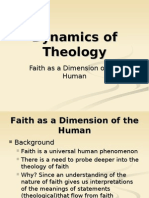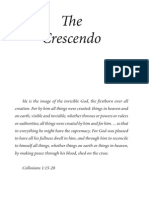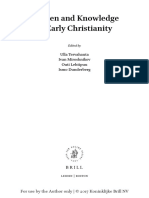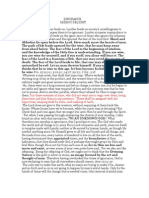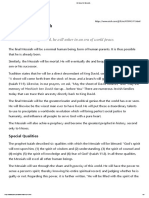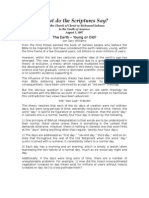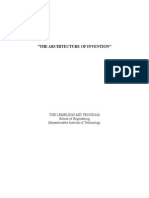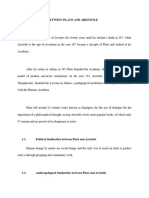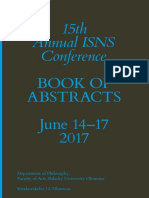Imagination and Faith
Imagination and Faith
Uploaded by
stipsa592Copyright:
Available Formats
Imagination and Faith
Imagination and Faith
Uploaded by
stipsa592Original Description:
Copyright
Available Formats
Share this document
Did you find this document useful?
Is this content inappropriate?
Copyright:
Available Formats
Imagination and Faith
Imagination and Faith
Uploaded by
stipsa592Copyright:
Available Formats
115
IMAGINATION
FAITH
By M I C H A E L
PAUL
AND
GALLAGttER
N 1976 U r s u l a le G u i n wrote a preface to h e r already a c c l a i m e d
w o r k of science fiction, The left hand of darkness, a n d in this new
addition she spoke deliberately in p a r a d o x e s :
I talk about the gods, I am an atheist. But I am an artist too, and
therefore a liar. Distrust everything I say. I am telling the t r u t h . . .
the truth is a matter of the imagination.
H a l f a c e n t u r y earlier, one of the greatest explorers of this t h e m e
wrote a p o e m called ' A h i g h - t o n e d old christian w o m a n ' , in which
he m o c k e d at the p u r i t a n tradition a n d a r g u e d that p o e t r y springs
m o r e j o y o u s l y f r o m exactly the s a m e source as religion - - h u m a n
imagination:
Poetry is the supreme fiction, madame.
Take the moral law and make a nave of it
And from the nave build haunted heaven. Thus,
The conscience is converted into palms,
Like windy citherns hankering for hymns.
We agree in principle. That's clear . . . .
A n d the
Wallace
obsessed
H e r e he
position:
piece continues as one of the typically playful p o e m s that
Stevens loved to p r o d u c e in the twenties, m a n y of t h e m
with the new role that i m a g i n a t i o n plays, if life is godless.
is p o n d e r i n g in a letter the d i l e m m a of his o w n atheist
If one no longer believes in God (as truth), it is not possible merely
to disbelieve; it becomes necessary to believe in something else.
Logically, I ought to believe in essential imagination, but that has
its difficulties. It is easier to believe in a thing created by the
imagination. 1
H e n c e , in his view, the calling of the poet is to ' c r e a t e his u n r e a l out
of w h a t is r e a l ' . I n a shoddy time of things, the poet will seek to
116
IMAGINATION
AND
FAITH
undermine 'the purely realistic mind', whether in literature or
religion, because such a mind 'never experiences any passion for
reality'.
It is on purpose that I begin with these two quirky and tantalizing
voices: they raise the level of discourse to that of wonderment. At
least at the outset they prevent us from speaking with questionable
reasonableness of what is essentially non-rational. Sometimes faith
is experienced, wrongly, as irrational, but it is always non-rational.
Aquinas pinpointed something crucially different about the knowing
involved in faith when he saw it as an act of the intellect commanded
by the will. More attractive definitions are only translations of that
insight into other vocabularies: faith is the knowledge born of love,
or an interplay between discernment and commitment} In this great
tradition of faith-analysis the claims to truth are met by the role
given to the mind, and the claims for freedom are met by the special
place reserved for decision. But is this the whole story? Surely a third
partner is involved and indeed centrally involved: even more
fundamentally than the proud tradition of intellect and will, h u m a n
imagination is the forgotten vehicle of faith. Theologies of faith too
dominated by reason are in constant danger of turning divine
mystery into a neat h u m a n system. Theologies of faith too
dominated by will can fall into two families: either dramatic appeals
to dark jumping, or else the severe self-imposed imperatives of
voluntarism (and ultimately of pelagianism).
If one returns to the New Testament in search of the language of
reason, one realizes suddenly and with some starkness to what
degree we are now the children of the rationalism of the Enlightenment. The voice of Pilate, who, in asking 'What is truth?', seems to
have had what Stevens would term 'a purely realistic mind', is a
faint one in the pages of scripture. But both his question about truth
and his wavelength of scepticism have been dominant in all the
complex rationalisms of the last few centuries. It is not at all
surprising that the atheist poet can have more in common with the
imaginative modes of scripture than some of our more rationalistic
theologians.
From that camp will come a predictable objection to any elevation
of imagination into membership, along with intellect and will, of a
new trinity of faith-faculties. Imagination, we shall be warned, is the
playground of artists, of people who tell lies that they claim to
embody some greater truth. But they are lies, nonetheless, as Plato
perceived before he banished the poets. However 'supreme' the
IMAGINATION
AND
FAITH
117
fictions, they are man-made, illusory, lacking in valid truth-claims;
gestures towards truth, perhaps, but not 'really' true. In all this
doubting of the imagination, however, what is lacking is a
distinction between the imaginary and the imaginative. In some of its
exercises imagination creates the (merely) imaginative, but in other
modes it can reveal the (truly) imaginative. Faith is imaginative, not
imaginary.
Once again the opposing voices may insist on a secondary and
subordinate role for imagination in any journey to faith or in any
understanding of faith. Advancing more subtle arguments this time,
their strategy is to deny to imagination a full partnership in the
knowing that is faith. One can imagine the counsel for the prosecution: 'Intellect and will are senior members but imagination can be
permitted to hold a respected place as a pastoral associate. Yes, of
course, Christ himself spoke to the crowds only in parables (as two of
the Synoptics baldly state). Yes, of course our images of God are
crucial in any communication of faith. Yes, of course the receptivity
of humankind before revelation is powerfully akin to the quality of
listening required by great poetry. Yes, of course the whole of the
bible is more literature than dogma in its level of discourse. But let's
be serious. Even if imagination has an important role in the genesis
of faith and in the spirituality that feeds the life of faith, and even if
imagination need not be equated with the imaginary, it is still
excessive to suppose that imagination can be a faculty of religious
truth. Imagination - - to be generous - - often prepares the way of
the Lord. But it does not enter into the core of the act of faith'.
In defence of imagination
The remaining pages of this article will resemble a courtroom
sequence, where we call witnesses for the defence of imagination
against this type of criticism. Drawing on a range of authors, several
of whom do not seem to know of the existence of their like-minded
colleagues, the aim will be to establish a case for imagination as a
crucial vehicle of faith. What will unite these witnesses, as members
of a rich if unacknowledged resistance movement, is their tendency
to downplay the knowledge dimensions, and to stress instead that
faith is much more (i) a matter of disposition or attitude that leads to
(ii) a special receptivity of searching and listening, which in turn
grounds (iii) a struggling way of living rather than a clear way of
knowing.
In this light one can see some of the older authors at pains to
118
I M A G I N A T I O N AND F A I T H
preserve a balance between the cognitive and the imaginative in the
process of faith. T h u s , to call our first witness, E. H. J o h n s o n would
hold that imagination has to do with 'vividness of mental seeing',
and that this is the hinge between the usual kind of knowing and the
trust that is so central in faith:
Religious faith is grounded in discernment of spiritual things. It is
first knowing, secondly imaging, thirdly trusting . . . . The recognition that spiritualities are realities can be put into most effective
exercise only by aid of imagination . . . . Faith . . . is the work of
imagination fortified by experience. 3
L o n g before developmental thinking b e c a m e self-conscious, J o h n s o n
was speaking of stages of faith, or envisaging it as a ' t r i p o d ' of
recognition, imagining and belonging in confidence to Christ: 'so far
as conversion of ideals into e n e r g y goes, it is all a m a t t e r of imaging
Christ'. A final statement from him will serve as a bridge back to an
older and more celebrated witness, J o h n H e n r y N e w m a n : 'It is
when imagination sounds the depths of f u n d a m e n t a l reality that this
reality begins to be felt . . . that is, to be veritably k n o w n and
actually faced.' This seems r e m a r k a b l y close in spirit to A grammar of
assent, where one of N e w m a n ' s constant concerns is a pre-reflective
e n c o u n t e r with o u r images, pictures, parables of divine reality. H e
takes the example of a child's imaginative a p p r e h e n s i o n of G o d and,
while admitting that it is incomplete as theology, he argues that it
offers a p a r a d i g m of adult faith: it is rooted in 'an image, before it
has been reflected on, and before it is recognized by him as a
notion'. 4 M a n y readers will be aware of N e w m a n ' s distinction
between a 'notional assent' (a theological act) and 'real assent' (an
act of religion or of devotion); but it is fascinating to learn that in the
drafts his initial choice of a phrase to express 'real assent' was in fact
'imaginative assent'.s His originality in this area lies in his emphasis
that faith needs first to b e c o m e credible to the imagination before it
can j o u r n e y towards a fuller and m o r e intellectual theology of faith:
Images, when assented to, have an influence both on the individual
and on society, which mere notions cannot exert . . . . The natural
and rightful effect of acts of the imagination upon us . . . is not to
create assent, but to intensify it . . . .
The heart is commonly
reached, not through the reason, but through the imagination.
After listening briefly to N e w m a n , o u r j u r y might benefit from
hearing from someone who has translated the relevance of these
IMAGINATION
AND
FAITH
119
m o r e - t h a n - c e n t u r y - o l d insights into the m o r e complex horizons of
today. J o h n C o u l s o n ' s recent book, Religion and imagination, explores
the parallels between the experience of faith and the experience of
literature, and holds that in both areas it is by m e a n s of the
imagination that we are 'predisposed to believe'. 6 In his view the
' p r i m a r y forms of religious belief' are not to be found in f o r m u l a t e d
truths and creeds but in the stranger modes of m e t a p h o r , symbol
and story. F r o m this point of view, it is a mistake to give precedence
to rational explanation over the imaginative assent as u n d e r s t o o d by
N e w m a n . Coulson would see this as an 'inversion of priorities in
religion'. T h u s his book begins from the question 'how can I believe
what I c a n n o t u n d e r s t a n d ? ' and his answer takes the form of a
n u a n c e d distinction between holding a belief a p p r e h e n d e d first by the
imagination a n d explaining it in some form of c o m p r e h e n d e d proof:
'religious belief originates in that activity we call i m a g i n a t i o n ' .
Before calling a n o t h e r m a j o r witness, it is worth drawing the
j u r y ' s attention to an almost exact echo of that final claim of
C o u l s o n ' s in a n o t h e r catholic researcher of the same period. T h e
sociological a p p r o a c h of A n d r e w Greeley has led him also to
the position that primordially religion is a function of the creative
imagination . . . (it) originates in our experiences of hope, experiences which are articulated and resonated in symbols which are
stories . . . . Religious images are a much stronger predictor of world
view than is doctrinal orthodoxy. Propositions which exist independent of any grounding in the creative imagination are likely to have
little impact on practical responses to suffering and tragedy. 7
The nature of imagination
But what is this ' i m a g i n a t i o n ' of which so m a n y speak? It can
seem a slithery t e r m pointing in several directions? For m a n y of the
c o m m o n - s e n s e thinkers of tl~e eighteenth century, imagination was a
power of p r o d u c i n g mental images of things in their absence (and
even as such it would be i m p o r t a n t for a n y religious perception of a
h i d d e n God). But for a later generation, from being a power of
visualizing what was absent, imagination now b e c a m e a god-like
and essentially creative agent. So, is imagination a secondary and
subordinate stage on the road to real knowledge? O r is it 'the living
power and prime agent of all h u m a n perception'. 9 This old debate
will find its echoes in the m o r e recent discussions c o n c e r n i n g the role
of imagination in faith.
It is time to call two m a j o r authorities to the witness box, in o r d e r
120
I M A G I N A T I O N AND F A I T H
b o t h t o clarify what is m e a n t by imagination and to state a strong
form of the claim that it constitutes a central language of faith. T h e
first is R i c h a r d K r o n e r , a philosopher of religion, who devoted m u c h
of his life to clarifying the non-cognitive and imagination-centred
nature of faith. It was from K r o n e r that I found m y own distinction
between the imaginary and the imaginative confirmed: ' T h e content
of the bible is not i m a g i n a r y but imaginative, whereas the content of
poems is not only imaginative but also i m a g i n a r y or fictitious. '1
K r o n e r would be openly hostile to any d o w n g r a d i n g of imagination
as 'the opposite of u n d e r s t a n d i n g ' , and his own works are i n t e n d e d
to justify the existence of what he terms 'spiritual imagination',
which is central to all religious faith. 11 It is through the m e d i u m of
imagination that revelation can be received, and hence a theology of
faith needs a different starting point than from the one that is usually
offered: 'the idea of G o d must be replaced by the image of G o d ' . O u r
knowledge of G o d is 'not theoretical or objective but imaginative
knowledge', or at least its
objectivity must be distinguished from scientific objectivity, because
it is inseparably connected with the subjectivity of religious
imagination. It is the peculiar and unique nature of ultimate truth
to demand the collaboration of reason and imagination; the isolated
intellect alone cannot find it.12
W h a t then is faith? Does it lose all claims to intelligent truth? K r o n e r
would reply with some qualifications that echo the stances taken b y
our earlier witnesses. O n the one h a n d , faith is m o r e a m a t t e r of
attitude than of verifiable knowledge in the usual sense: it is 'the
accurate and the a d e q u a t e attitude of finite m a n towards the selfrevelation of G o d ' . O n the other h a n d , faith should not be too
d e m e a n i n g in a b a n d o n i n g claims to truth: it is not 'a lower degree of
knowledge; it is something wider than all knowledge, something
different in principle from all knowledge'. 13
If there is time to call only one other witness to testify at any
length, William L y n c h will b r i n g our case to a w o r t h y climax. It is a
topic that he has m e d i t a t e d t h r o u g h a l o n g career, and he can
provide some of the clearest and most persuasive descriptions of
imagination:
The imagination is not an aesthetic faculty. It is not a single or
special faculty. It is all the resources of man, all his faculties, his
whole history, his whole life, and his whole heritage brought to bear
IMAGINATION
AND FAITH
121
upon the concrete world inside and outside of himself, to form
images of the world, and thus to find it, cope with it, shape it, even
make it. The task of the imagination is to imagine the real . . . . The
religious imagination . . . . tries literally to imagine things_with God.
. . The imagination is really the only way we have of handling the
world. 14
F r o m this basis it is a short step to thinking of faith either as 'a way
of experiencing and imagining the world' or as a 'world within
which we experience or imagine'.15 In words that seem very close to
N e w m a n and Coulson, L y n c h would invite us to 'try reversing o u r
images' and to u n d e r s t a n d faith as 'a first and primitive force in
life', something universally operative but pre-rational: 'rationality
will later come in' to help in the search for explicit meaning. Faith
precedes knowledge but it does need to progress towards knowledge:
'the p o w e r and b e a u t y of faith or imagination d e p e n d on a progressive relationship with reality, and revelation. Otherwise faith
remains a p e r m a n e n t child'. It is no coincidence that both N e w m a n
and L y n c h take the example of the child to explain the role of
imagination in faith a n d at the same time the need for faith to
e x p a n d from its cherished and crucial seed-bed in imagination.
'Unless one becomes as a little child' can be re-read as pointing to
the non-intellectual and non-voluntarist gateway to faith t h r o u g h
images and w o n d e r m e n t and listening. Is imagination m o r e than a
gateway? M u s t not the essential m o m e n t of the 'child' be transcended as faith progresses into knowledge? L y n c h would hold that
faith remains stunted unless it finds e m b o d i m e n t both in a vertical
belief in G o d and in the horizontal 'belief m e n have in each other'.
At the same time h e would not see this m a t u r e faith as a b a n d o n i n g
imagination, as a space-craft might jettison its l a u n c h i n g rocket.
T h e r e is a t e m p t a t i o n to r e d u c e the role of imagination in this way,
by limiting it to an initial rhetoric or affective invitation into the li'fe
of faith This line of thinking would allow to imagination only a
p r e p a r a t o r y usefulness as a psychological or pastoral tool. In a m o r e
recent article William L y n c h protests against this 'belittling' and
seeks t o establish instead a view of 'the imagination as place of
t h o u g h t ' . As against a t e n d e n c y (even a m o n g some of our previous
witnesses) to polarize the world of images and the world of ideas,
L y n c h wants us to recognize the imagination as a form of
intelligence or u n d e r s t a n d i n g from its beginnings: 'images a n d the
imagination that creates t h e m must be seen as bearers of cognition,
truth, knowledge' 16
122
IMAGINATION
AND FAITH
If conceptual ideas alone can aspire to valid knowledge, we would
seem condemned to a divorced and fruitless language of faith. But
when imagination is admitted as a primary colleague of theological
thought, then the faith one defends will be one that does more justice
to the double mystery of humanity and of divinity. Ultimately it is
through imagination that we cope with the difficult docking
manoeuvre between a hidden God and a fallen humanity. If that
meeting is the foundation of faith, then one touches at once on two
reasons why imagination is crucial: we do not see God directly, and
often we do not want to hear him or hear of him (the hearing whence
faith comes). In this situation of essential struggle, it is imagination
that helps us to escape from fantasy and falsehood, to be healed into
hope, and to receive new vision from the image of God made man. 17
Postscript
Our appeal to the jury must rest there. But two further points
deserve brief mention. M a n y important witnesses were unable to be
cited this time. The h a n d f u l that we have heard may represent an
intriguing convergence but the club has other potential members. So
one should at least list a few authors and titles: Ray Hart, Unfinished
man and the imagination (1968); Julian Hartt, Theological method and
imagination (1977); Gordon Kaufman, The theological imagination;
Rosemary Haughton, The passionate God; J o h n Navone and Thomas
Cooper, Tellers of the Word; David Tracy, The analogical imagination
(all 1981); Avery Dulles, Models of revelation (1983), and, in
somewhat different vein, much of the writing of Hans Urs yon
Balthasar.
Finally one might hint at the possible relevance of this field for a
new apologetics. The old apologetics has become not so much
untrue as inadequate within a very different cultural context. The
newer culture, especially in some of its youth forms, often seems a
more poetically exploratory one than before. If so, a corfler-stone for
any new apologetics would be to grasp that the language of knowing
God is primarily the language of images. O u r colder forms of
discourse get the wavelength wrong. A case could be made that the
God of the bible seldom either argues or orders; instead he recites
poems and tells stories and invites to freedom by way of images. Out
of this revelation springs faith, a revelation where imagination is a
central strand in the communication of mystery and in its continued
life - - both as receiving apparatus and as fostering agency. And in
so far as faith is much closer to an active attitude than to a piece of
I M A G I N A T I O N AND F A I T H
123
knowledge, it will continue to be shaped and nourished less by clear
concepts than by the many images, acknowledged or not, that each
person has of his or her life and of its hopes.
NOTES
I Letters of Wallace Stevens, ed. Holly Stevens (New York, 1966), p 370. Other prose quotations
from Stevens here are from The necessary angel (New York, 1951), p 58 and Letters, p 597.
2 See Bernard Lonergan, Method in theology (London, 1971), p 115, and Avery Dulles, 'The
meaning of faith considered in relationship to justice', in The faith that doesjustice, ed. John
Haughey (New York, 1977), p 13.
3Johnson, E. H.: The religious use of imagination (New York, 1901), pp 43, 134. Other
quotations from Johnson are from pp 9, 187, 63.
4 Newman, J. H.: A grammar of assent (London, 1909), p 115. Subsequent quotations are from
pp 117, 75, 82, 92.
5 Coulson, John: Religion and imagination (Oxford, 1981), pp 82-83.
6 Ibid., p 55. Further quotations from Coulson come from pp 16, 34, v, 46.
7 Greeley, Andrew: Religion: a secular theory (New York, 1982), pp 48, 68, 98.
e See James Engell's The creative imagination (Cambridge, Mass., 1981). See also Ernest
Tuveson, The imagination as a means of grace (Berkeley, 1960), and Mary Warnock, Imagination
(London, 1976).
9 Coleridge, S. T.: Biographia literaria, chapter 13.
10 Kroner, Richard: The religiousfunction of imagination (New Haven, 1941), p 36.
11 Kroner, Richard: Betweenfaith and thought (New York, 1966), pp 98, 101.
12 Kroner, Richard: The religiousfunction of the imagination, pp 33~ 63.
13 Kroner, Richard: How do we know God? (New York, 1943), pp 98, 9.
14 Lynch, William: Christ and Prometheus: a new image of the secular (Notre Dame, 1970), p 23.
15 Lynch, William: Images offaith (Notre Dame, 1973), p 17. Further quotations come from
pp 36-37, 97, 57.
16 Lynch, William: 'The life of faith and imagination', Thought, lvii (1982), pp 14, 9.
17 These phrases draw on some other expressions of William Lynch in his book Images of hope
(New York, 1966), p 209.
You might also like
- AASHTO 93 Guide For Design of Pavement StructuresDocument624 pagesAASHTO 93 Guide For Design of Pavement StructuresRicardo Alfaro100% (19)
- THE GOD SEDEQ - Roy RosenbergDocument18 pagesTHE GOD SEDEQ - Roy RosenbergFrancisco Ramón ConcepciónNo ratings yet
- Plato's Theory of ImitationDocument2 pagesPlato's Theory of ImitationAnkitRoy82% (17)
- Moulana Shah Maghsoud - The Verbal UnityDocument1 pageMoulana Shah Maghsoud - The Verbal UnityMohammed Abdul Hafeez, B.Com., Hyderabad, IndiaNo ratings yet
- Philosphy Plan Pol SciDocument4 pagesPhilosphy Plan Pol SciJunaidNo ratings yet
- Faith Chapter 1Document17 pagesFaith Chapter 1frances leana capellan100% (1)
- Emily Dickinson and The Mysterious Kingdom of Heaven WithinDocument17 pagesEmily Dickinson and The Mysterious Kingdom of Heaven Withinroache5456No ratings yet
- Belonging in The TempleDocument10 pagesBelonging in The TempleScott TaylorNo ratings yet
- Kyrios Jesus As The Angel of The Lord in Jude 57Document18 pagesKyrios Jesus As The Angel of The Lord in Jude 57lundc9603100% (1)
- Yahweh Notes וה yhwh YahwehDocument17 pagesYahweh Notes וה yhwh YahwehAmon SakifiNo ratings yet
- Theology and Demonology in Qumran Texts: Henoch January 2010Document30 pagesTheology and Demonology in Qumran Texts: Henoch January 2010Njono Slamet100% (1)
- What Is A Pharisee?Document7 pagesWhat Is A Pharisee?banginoNo ratings yet
- Creation and The Fall, Part III and IVDocument11 pagesCreation and The Fall, Part III and IVJustin SynnestvedtNo ratings yet
- Four Beasts of Daniel VisionDocument4 pagesFour Beasts of Daniel VisionBarnabas TiburtiusNo ratings yet
- The Rainbow Prophesy of Jesus ChristDocument4 pagesThe Rainbow Prophesy of Jesus ChristDavid EhrlichNo ratings yet
- Crescendo (Chapter 6)Document11 pagesCrescendo (Chapter 6)Andre100% (2)
- Joachim of Fiore and Apocalyptic ImmanenceDocument34 pagesJoachim of Fiore and Apocalyptic ImmanenceCrown LotusNo ratings yet
- Christian H. Bull (2017) - Women Angels and Dangerous Knowledge, en Women and Knowledge in Early Christianity. Brill, 75-107.Document36 pagesChristian H. Bull (2017) - Women Angels and Dangerous Knowledge, en Women and Knowledge in Early Christianity. Brill, 75-107.sevasteh100% (1)
- Adonai, Therefore, Emphasizes The Sovereignty of God, The Lordship of God. The Meaning of Adonai in The Hebrew Language, God Is LordDocument106 pagesAdonai, Therefore, Emphasizes The Sovereignty of God, The Lordship of God. The Meaning of Adonai in The Hebrew Language, God Is Lordashu2012No ratings yet
- 3.sons of SethDocument24 pages3.sons of SethmarcaurelioperseuNo ratings yet
- Creation in PsalterDocument9 pagesCreation in PsalterDexz Valeroso IgnacioNo ratings yet
- The Two TreesDocument8 pagesThe Two Treesapi-268728645No ratings yet
- Did God Create ChaosDocument20 pagesDid God Create ChaosabbraxasNo ratings yet
- The Nephilim: Their Origins and EvolutionDocument11 pagesThe Nephilim: Their Origins and Evolutiontodayperhaps100% (3)
- The Descriptive Titles of Jesus in the Quran: (English - ي�ﻴ�إ)Document9 pagesThe Descriptive Titles of Jesus in the Quran: (English - ي�ﻴ�إ)Dubstep ImtiyajNo ratings yet
- Passover MeditationsDocument60 pagesPassover MeditationsKingdom WitnessNo ratings yet
- Rapture: The Term Rapture Does Not Exist in The Bible. It Is Only Implied in 1 Thes 4:17:"caught Up in The Clouds To Meet The Lord in The Air"Document4 pagesRapture: The Term Rapture Does Not Exist in The Bible. It Is Only Implied in 1 Thes 4:17:"caught Up in The Clouds To Meet The Lord in The Air"Francis Njihia Kaburu100% (2)
- Gospel of The HebrewsDocument13 pagesGospel of The HebrewstactoucNo ratings yet
- Zerubbabel Two WitnessesDocument52 pagesZerubbabel Two WitnessesMark Lex Guevarra BarriosNo ratings yet
- ARCHAEOLOGICAL DIGGINGS Com Englishmagazines 176 PDFDocument68 pagesARCHAEOLOGICAL DIGGINGS Com Englishmagazines 176 PDFmacNo ratings yet
- Appointed Times 2015Document2 pagesAppointed Times 2015Lew WhiteNo ratings yet
- The Acts of ThomasDocument71 pagesThe Acts of Thomascarmen.nitu7100% (1)
- Auss20070401 V45 01Document164 pagesAuss20070401 V45 01mateiflorin07No ratings yet
- JONAH: The Prophet Who Ran AwayDocument18 pagesJONAH: The Prophet Who Ran AwayHerrieGabica100% (1)
- Satan in The Book of JobDocument19 pagesSatan in The Book of JobGemechis BuliNo ratings yet
- The Living God - Edmond Jacob - Theology of The Old TestamentDocument7 pagesThe Living God - Edmond Jacob - Theology of The Old TestamentBogdan SoptereanNo ratings yet
- JOSHUAS OF HEBREWS 3 AND 4 Bryan J WhitfieldDocument16 pagesJOSHUAS OF HEBREWS 3 AND 4 Bryan J WhitfieldRichard Mayer Macedo SierraNo ratings yet
- The Jewish Targums and John's Logos TheologyDocument3 pagesThe Jewish Targums and John's Logos TheologyJim WestNo ratings yet
- Middleton R. D. Logos and Shekinah in The Fourth Gospel, JQR 29 (1938), 101-133Document33 pagesMiddleton R. D. Logos and Shekinah in The Fourth Gospel, JQR 29 (1938), 101-133yadatanNo ratings yet
- Ignorance - Satan's DelightDocument4 pagesIgnorance - Satan's DelightS D AnzNo ratings yet
- ExegeticalPaper2 Isaiah40 1 11 JaphetsDocument10 pagesExegeticalPaper2 Isaiah40 1 11 JaphetsLuis AlbertoNo ratings yet
- The Origin of Sin in Irenaeus and Jewish Pseudepi-Graphical Literature PDFDocument31 pagesThe Origin of Sin in Irenaeus and Jewish Pseudepi-Graphical Literature PDFManticora VenerandaNo ratings yet
- All About The MessiahDocument5 pagesAll About The Messiahdougmungavin3744No ratings yet
- Darkness Over All The LandDocument58 pagesDarkness Over All The LandAnders GunnarNo ratings yet
- Universalism and Predestinarianism A CRDocument24 pagesUniversalism and Predestinarianism A CRCladius FrassenNo ratings yet
- Teen: Young Earth, Old Earth, Which Is It?Document3 pagesTeen: Young Earth, Old Earth, Which Is It?The Richmond Church of ChristNo ratings yet
- Jack Cottrell 2000 The Gender of Jesus and The IncarnationDocument16 pagesJack Cottrell 2000 The Gender of Jesus and The Incarnationhenkus1No ratings yet
- Tasting The Reign of God - The Meal Ministry of Jesus Joncas - Spring2000Document37 pagesTasting The Reign of God - The Meal Ministry of Jesus Joncas - Spring2000Big Chair100% (1)
- 2 Thessalonians 1Document2 pages2 Thessalonians 1Crystal SamplesNo ratings yet
- 593 593 1 PBXDocument21 pages593 593 1 PBXNorthman57No ratings yet
- The Devil in The Old Testament1Document14 pagesThe Devil in The Old Testament1wilfredo torresNo ratings yet
- The Cross and The Sanctuary IDocument2 pagesThe Cross and The Sanctuary IuniversitysdaNo ratings yet
- Creation and Origin of EvilDocument21 pagesCreation and Origin of EvilJohn PailyNo ratings yet
- JoshuaDocument28 pagesJoshuacpmacauNo ratings yet
- Biblical Examples of Nephilim ResurrectionDocument2 pagesBiblical Examples of Nephilim Resurrectionpastorrlc8852100% (1)
- We Are Being Transformed Deification in Paul's Soteriology by M. David LitwaDocument340 pagesWe Are Being Transformed Deification in Paul's Soteriology by M. David LitwaJavi de Saint-ClairNo ratings yet
- Apostolic CollectionsDocument126 pagesApostolic CollectionsRoss100% (1)
- The Genesis PluralsDocument9 pagesThe Genesis PluralsmanuelmcorreaNo ratings yet
- The Moral Argument For GodDocument6 pagesThe Moral Argument For GodFrederick MeekinsNo ratings yet
- Son of Man-SpiritDocument25 pagesSon of Man-SpiritEnokmanNo ratings yet
- Doubleportioninheritance Blogspot Com 2011 07 Does-NameDocument15 pagesDoubleportioninheritance Blogspot Com 2011 07 Does-Nameapi-231781675100% (1)
- Who Really Wrote The GospelsDocument16 pagesWho Really Wrote The GospelsJan Paul Salud LugtuNo ratings yet
- The Holy Bible Code: God's Finished & Perfected Word as Revealed in the King James Version, Volume 3From EverandThe Holy Bible Code: God's Finished & Perfected Word as Revealed in the King James Version, Volume 3No ratings yet
- psd2 Rts 2017 7782 - enDocument31 pagespsd2 Rts 2017 7782 - enstipsa592No ratings yet
- The Globalisation of Modern ArchitectureDocument30 pagesThe Globalisation of Modern Architecturestipsa59250% (2)
- The Structure and Ground State Dynamics of Ar-IHDocument7 pagesThe Structure and Ground State Dynamics of Ar-IHstipsa592No ratings yet
- Architecture Competition Annual 2008Document156 pagesArchitecture Competition Annual 2008stipsa592No ratings yet
- Toolkit FinalDocument121 pagesToolkit Finalstipsa592100% (1)
- Biomimetic ArchitectureDocument6 pagesBiomimetic Architecturestipsa5920% (1)
- Fashion in Motion Kansai YamamotoDocument2 pagesFashion in Motion Kansai Yamamotostipsa592No ratings yet
- "The Architecture of Invention": The Lemelson-Mit Program School of Engineering Massachusetts Institute of TechnologyDocument51 pages"The Architecture of Invention": The Lemelson-Mit Program School of Engineering Massachusetts Institute of TechnologyCik AnoiNo ratings yet
- Anonimno Surfanje I Zastita Od SpijunazeDocument42 pagesAnonimno Surfanje I Zastita Od SpijunazeperopericblNo ratings yet
- Coffey-The Palamite Doctrine of GodDocument31 pagesCoffey-The Palamite Doctrine of Godmomesansnom100% (1)
- Etchemendy, J. (1983) - The Doctrine of Logic As FormDocument16 pagesEtchemendy, J. (1983) - The Doctrine of Logic As FormY ́ GolonacNo ratings yet
- LOVE - Gabriel MarcelDocument73 pagesLOVE - Gabriel MarcelfirNo ratings yet
- DFGHJDocument129 pagesDFGHJKatarina MilojevićNo ratings yet
- Similarities Between Plato and AristotleDocument8 pagesSimilarities Between Plato and AristotleScribdTranslationsNo ratings yet
- Ismaili SchoolDocument9 pagesIsmaili SchoolIzaan Rizvi0% (1)
- EnlightenmentDocument32 pagesEnlightenmentjfern014100% (1)
- 2 The Social Dimension of Human ExistenceDocument46 pages2 The Social Dimension of Human ExistenceLovely Rose CobarNo ratings yet
- Pippin - Hegel's Metaphysics and The Problem of ContradictionDocument13 pagesPippin - Hegel's Metaphysics and The Problem of ContradictionRobertHorningNo ratings yet
- CLAIM ChurchesDocument5 pagesCLAIM ChurchesShekinah Grace SantuaNo ratings yet
- Dynamic of Faith's SummaryDocument5 pagesDynamic of Faith's SummarymikhaelohimNo ratings yet
- A Conversation With Jacques DerridaDocument5 pagesA Conversation With Jacques DerridarwouweltjesNo ratings yet
- (Ralph Cudworth) Ralph Cudworth A Treatise Concer (BookFi)Document260 pages(Ralph Cudworth) Ralph Cudworth A Treatise Concer (BookFi)Ioannis CordasNo ratings yet
- Riff-Raff - Richard Gunn - Marxism, Metatheory and CritiqueDocument12 pagesRiff-Raff - Richard Gunn - Marxism, Metatheory and CritiquebordigaNo ratings yet
- What Is Islamic Esotericism?: Liana SaifDocument59 pagesWhat Is Islamic Esotericism?: Liana Saifibn_arabiNo ratings yet
- Michael Clark - Paradoxes, No. 3 - Buridan's AssDocument2 pagesMichael Clark - Paradoxes, No. 3 - Buridan's AssKubaNo ratings yet
- Unit 7 Type of EntailmentDocument4 pagesUnit 7 Type of EntailmentDieu HuyenNo ratings yet
- Philosophical Tools and ProcessesDocument30 pagesPhilosophical Tools and ProcessesSolaiman Ayunan100% (3)
- Ibn RushdDocument5 pagesIbn RushdMushtak Mufti100% (2)
- Philosophy of ScienceDocument198 pagesPhilosophy of ScienceNazir100% (1)
- ISNS 2017 Book of AbstractsDocument95 pagesISNS 2017 Book of AbstractsSardanapal ben EsarhaddonNo ratings yet
- Why and When A ReformerDocument2 pagesWhy and When A ReformerHaseeb AhmadNo ratings yet
- Module 1. The Self From Various Philosophical PerspectivesDocument7 pagesModule 1. The Self From Various Philosophical PerspectivesNaharia RangirisNo ratings yet
- Davidson Knowing One S Own MindDocument19 pagesDavidson Knowing One S Own MindBarnabyIsAwesomeNo ratings yet
- Philosophy PGSyllabus CCSU July28Document18 pagesPhilosophy PGSyllabus CCSU July28Paran GoswamiNo ratings yet
- Positivism TheoryDocument2 pagesPositivism TheoryAhamed Ibrahim100% (1)
- Existentialist EthicsDocument6 pagesExistentialist EthicsCarlos Peconcillo ImperialNo ratings yet





